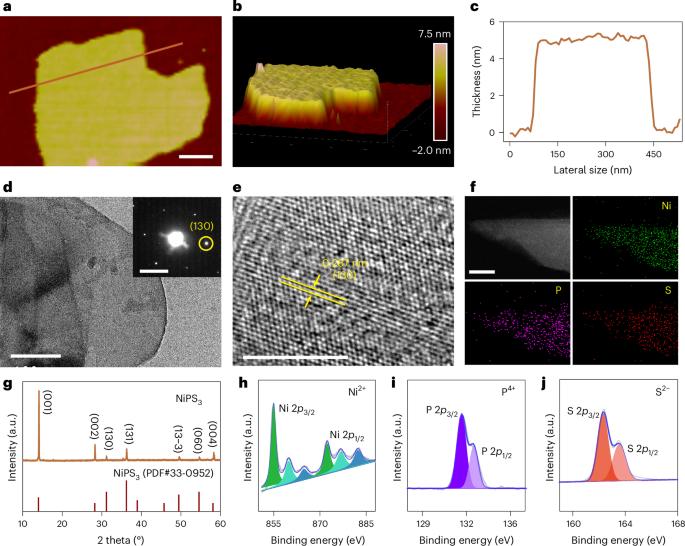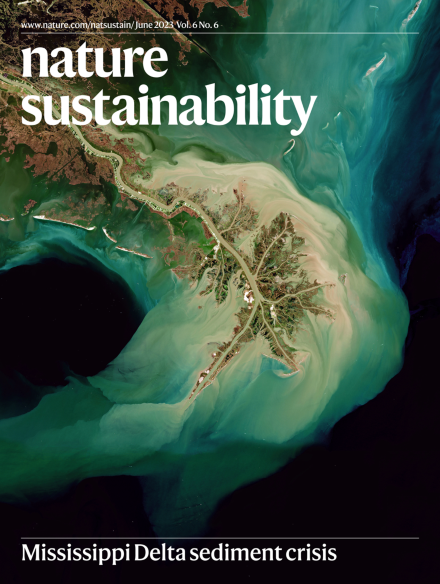Stable and high-yield hydrogen peroxide electrosynthesis from seawater
IF 27.1
1区 环境科学与生态学
Q1 ENVIRONMENTAL SCIENCES
引用次数: 0
Abstract
Electrocatalytic two-electron oxygen reduction reaction (2e− ORR) in seawater offers a sustainable route for hydrogen peroxide (H2O2) production. However, due to the high concentration of Cl− ions and competitive 4e− ORR, there is a lack of efficient and long-term stable seawater electrocatalysts. Here we report a high-performance electrocatalyst design based on NiPS3 nanosheets enabling efficient H2O2 production from seawater. Specifically, the NiPS3 nanosheets deliver a 2e− ORR selectivity of ∼98%, a H2O2 yield of 6.0 mol gcat−1 h−1 and robust stability for over 1,000 h in simulated seawater. Underlying the exciting performance is the synergy of the S2−, Ni2+ and P4+ sites where the octahedral S2− skeleton repels Cl− ions, the Ni2+ sites enable the modest binding strength of *OOH intermediate, and the P4+ sites interact with H2O to trigger the protonation of proximal O atom of *OOH. The seawater electrocatalysis system also allows for scalable synthesis of solid H2O2, tandem oxidation reaction of biomass to organic acid and direct use of the produced H2O2 as a sterilizing agent. Once integrated with photovoltaics, the solar-powered electrolysis device can operate in real seawater. Our findings pave the way for sustainable conversion of seawater into value-added products. Hydrogen peroxide (H2O2) is a green oxidant with diverse applications. Aided by a nickel phosphorus trisulfide nanosheet electrocatalyst, this work shows a sustainable synthetic route to produce H2O2 from seawater with high yield and impressive stability.

稳定、高产的海水电合成过氧化氢
海水中电催化双电子氧还原反应(2e−ORR)为生产过氧化氢(H2O2)提供了一条可持续的途径。然而,由于Cl−离子的高浓度和竞争性的4e−ORR,缺乏高效、长期稳定的海水电催化剂。在这里,我们报道了一种基于NiPS3纳米片的高性能电催化剂设计,可以从海水中高效地生产H2O2。具体来说,NiPS3纳米片的2e - ORR选择性为~ 98%,H2O2产率为6.0 mol gcat - 1 h - 1,并且在模拟海水中具有超过1000小时的稳定性。这一令人兴奋的表现背后是S2 -, Ni2+和P4+位点的协同作用,其中八面体S2 -骨架排斥Cl -离子,Ni2+位点使*OOH中间体具有适度的结合强度,P4+位点与H2O相互作用触发*OOH近端O原子的质子化。海水电催化系统还可以大规模合成固体H2O2,将生物质串联氧化成有机酸,并直接使用生成的H2O2作为灭菌剂。一旦与光伏集成,太阳能电解装置就可以在真正的海水中运行。我们的发现为可持续地将海水转化为增值产品铺平了道路。过氧化氢(H2O2)是一种具有多种用途的绿色氧化剂。在三硫化镍磷纳米片电催化剂的帮助下,这项工作展示了一种可持续的从海水中生产H2O2的合成途径,具有高产率和令人印象深刻的稳定性。
本文章由计算机程序翻译,如有差异,请以英文原文为准。
求助全文
约1分钟内获得全文
求助全文
来源期刊

Nature Sustainability
Energy-Renewable Energy, Sustainability and the Environment
CiteScore
41.90
自引率
1.10%
发文量
159
期刊介绍:
Nature Sustainability aims to facilitate cross-disciplinary dialogues and bring together research fields that contribute to understanding how we organize our lives in a finite world and the impacts of our actions.
Nature Sustainability will not only publish fundamental research but also significant investigations into policies and solutions for ensuring human well-being now and in the future.Its ultimate goal is to address the greatest challenges of our time.
 求助内容:
求助内容: 应助结果提醒方式:
应助结果提醒方式:


